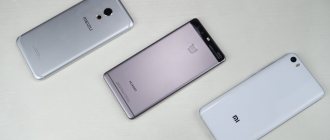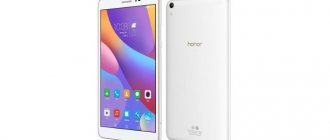- Equipment
- Appearance
- Dimensions
- Screen
- Performance
- Autonomy
- Camera
- Wireless technologies/operating system
- comparison table
- Conclusion
For those who want to become the owner of a multifunctional and truly powerful gadget, two manufacturers offer an excellent solution. We are talking about flagships from Huawei and Xiaomi, which are considered one of the best in their line. Our review will be devoted to comparing Honor 9 and Xiaomi Mi6, because they are worthy competitors.
Specifications
Before we get into the Xiaomi Mi6 vs Huawei Honor 9 clash in detail, let's first take a close look at their specifications. This will at least help us better understand the equipment of both devices and their basic capabilities.
Xiaomi Mi6:
- Single-chip system: Processor – eight-core Qualcomm Snapdragon 835 (4 Kryo cores 2.45 GHz, 4 Cortex A-53 cores 1.9 GHz) Graphics accelerator – Adreno 540 710 MHz;
- Display: 5.15 inches, IPS matrix, Full HD (1920x1080), pixel density 428 PPI;
- Operating system: Android 7.1.1 plus proprietary MIUI 8.0 shell;
- Memory: RAM – 6 gigabytes. Main – 64 or 128 gigabytes;
- Supported frequencies : GSM 850/900/1800/1900 MHz, UMTS 800/850/900/1700/1900/2100 MHz, LTE 1, 3, 5, 7, 8;
- Wireless interfaces: Bluetooth 5.0, Wi-Fi (802.11ac, 2×2 MIMO, MU-MIMO), NFC;
- Cameras: Main – 12 megapixels, f/1.8 aperture, 27 mm focal length, 4-axis optical stabilization, plus a 12 megapixel camera with a 52 mm telephoto lens, f/2.6 aperture. Front – 8 megapixels, f/2.0 aperture;
- Navigation: GPS, GLONASS, Beidou;
- Set of sensors: Light sensor, proximity sensor, accelerometer, gyroscope, digital compass, fingerprint scanner;
- Battery: 3350 milliamp hours;
- Dimensions: Dimensions – 145.17x70.49x7.45 mm. Weight - 168 grams.
Honor 9:
- Single-chip system: Processor – eight-core HiSilicon Kirin 960 (4 Cortex A-73 2.4 GHz cores, 4 Cortex A-53 1.8 GHz cores) Graphics accelerator – Mali-G71MP8 1037 MHz;
- Display: 5.15 inches, IPS matrix, Full HD (1920x1080), pixel density 428 PPI;
- Operating system: Android 7.0 plus proprietary shell Emotion UI 5.1;
- Memory: RAM – 4 or 6 gigabytes. Main – 64 or 128 gigabytes, micro-SD support up to 256 gigabytes;
- Supported frequencies : 2G (850/900/1800/1900); 3G (850/900/1700/1900/2100); 4G (b1/b3/b5/b7/b8/b20/b38/b40/b41);
- Wireless interfaces: Bluetooth 4.2, Wi-Fi 802.11a/b/g/n/ac 2.4 and 5 GHz, NFC;
- Cameras: Main 0 12 megapixel RGB, f/2.2 aperture, plus 20 megapixel monochrome camera, f/2.2 aperture. Front – 8 megapixels, f/2.0 aperture;
- Navigation: GPS, GLONASS, Beidou;
- Set of sensors: Proximity sensor, lighting sensor, magnetic field sensor, accelerometer, gyroscope, step counter, fingerprint scanner;
- Battery: 3200 milliamp hours;
- Dimensions: Dimensions – 147.3x70.9x7.45 mm. Weight – 155 grams.
As you can see, the parameters of smartphones are really very similar. For the most part, they differ only in single-chip systems and the camera, but otherwise the differences are not so significant. Well, let's see how the phones behave in a direct comparison.
Performance
When choosing Honor 9 or Xiaomi Mi6, you should pay attention to the performance of these smartphones. The Honor 9 device uses a 64-bit processor of its own design, called HiSilicon Kirin 960. In addition to 8 cores, an i6 coprocessor is installed, which reduces power consumption.
The main processor of Honor 9 supports 2 cameras and 4K video. The smartphone works quickly and without lags. The user does not have any problems with games and other applications. The smartphone body does not overheat while using applications.
The Xiaomi Mi 6 device is a smartphone built on the Qualcomm Snapdragon 835 platform. The processor supports the Bluetooth 5.0 standard, which allows you to play stereo sound on 2 speakers or headphones.
The smartphone works quickly and shows excellent results in various tests. It is suitable for everyday use, but during the Antutu test the smartphone heated up to 40°. As a result, applications began to freeze. This is due to insufficiently high-quality firmware, which does not use all the capabilities of the hardware.
Equipment
Comparing Mi6 and Honor 9 in terms of equipment turned out to be not as simple as we initially thought. And the main problem here is that there is nothing special to compare. Both smartphones are supplied in rather unassuming white boxes made of thick cardboard. The box for Xiaomi looks quite standard, while the Honor 9 and its components are located inside in a rather unusual vertical way, like books on a shelf. Apart from this interesting detail, the rest of the equipment is almost identical. So, in both boxes we were able to find:
Xiaomi Mi6
- USB Type-C cable for charging and synchronization.
- Included 2 amp charger.
- Silicone bumper on the back cover.
- A paperclip for removing the SIM card tray.
- Accompanying documentation.
The only slight difference is that the Mi6 also has a special adapter from USB Type-C to a standard 3.5 mm headphone jack in the box, because the phone itself is not equipped with such a jack. Honor 9 has such a connector on the body of the smartphone itself, so naturally such an accessory is not included in its package.
Honor 9
Screens
Both the new smartphones come with a large 5.15-inch IPS screen. This screen has a resolution of 1080 pixels (supports Full HD) and has Corning Gorilla Glass coating. Further, we can note the identical screen-to-body ratio of the device - for Mi 6 it is around 71.4%, and for Honor 9 it is about 69.9%.
Despite the similarity of the matrices, slight differences are still noticeable. Honor 9 has a better color scheme than its opponent. But Mi 6 has a much deeper black tint. In terms of balance tools, Huawei has an advantage, since it allows for more precise settings.
Design is a new trend of Chinese manufacturers
In the design of both smartphones, general trends can be seen quite clearly. Now many Chinese manufacturers have developed a love for glass phone cases and dual camera modules. This is not to say that this is something bad, at least this trend has not yet become boring and is gradually being replaced by another trend for full-screen devices.
In this case, we have phones with a metal body, which is completely covered with tempered glass on both sides, and the only thing that reminds us of metal is the glossy insert around the perimeter of the entire body, where the main functional elements are located. Smartphones have sloping edges for a more comfortable hold in the palm, as well as neatly beveled corners. Both devices are quite compact and have dimensions of 147.3 x 70.9 x 7.45 mm for Honor and 145.17 x 70.49 x 7.45 mm for Xiaomi. As you can see, Xiaomi is somewhat smaller than its competitor, which can be regarded as an advantage by some buyers. At the same time, the Mi6 is a little heavier - 168 grams versus 155 for its opponent.
The phones are sold in several colors. For Xiaomi, this is traditional black, the always popular white, and also the new blue-gold color. Huawei decided to name its shades more original, resulting in: midnight, sapphire and icy gray. Both smartphones look great, but Xiaomi has a simpler glossy back cover that can change color slightly in the sun.
Honor's back cover is multi-layered and made using photo-engraving technology, thanks to which the smartphone has a very beautiful shimmer effect that makes the phone look very unusual. If we compare the Mi6 and Honor 9 regarding the practicality of their cases, then Honor will also win. In addition to beauty, the back cover of the “nine” also seems to be stronger than that of its rival, it is less susceptible to scratches, chips, and also does not slide as much on flat surfaces, unlike the Mi6.
Our today's heroes also resemble each other in terms of the placement of functional elements. However, there is still a slight difference, since Xiaomi Mi6 is not equipped with a 3.5 mm jack, while Honor has this port located on the bottom end near USB-C and the main speaker. Xiaomi has in this place, in addition to the above-mentioned main port and speaker, only a second decorative grille, under which the speaking microphone is hidden.
Otherwise, the smartphones are almost identical, so in both cases we see a dual camera with LED flash on the back cover, a fingerprint scanner at the bottom on the front panel, and a speaker, front camera and sensors at the top. At the top end there is an active noise reduction microphone and an infrared port, and on the sides there are standard volume control buttons and a lock key on one side, and a SIM card tray on the other.
It is not easy to give preference to Huawei Honor 9 or Xiaomi Mi6 in terms of the quality of their design. The point is not that they are both good, but that the issue of design is mostly a matter of the individual taste of each buyer. Subjectively, in our opinion, Honor looks a little more attractive, but we don’t see much point in evaluating smartphones based on this block.
Design and ergonomics
In Honor 9, Huawei designers continue the ideas of last year's Honor 8 (review). Bright, iridescent glass panels on both sides and a metal frame in the color of the body.
But compared to Honor 8, the new Honor 9 also focuses on competing with other Chinese smartphones. At the first glance at Honor 9, you want to scream - “Yes, this is an analogue of Xiaomi Mi 6, but from Huawei!”
In many ways, this is true, because the appearance of Honor 9 is very similar to the shape of Xiaomi Mi6. Apparently, this design is now in trend in the Chinese market, since smartphones from famous brands come out so similar.
But be that as it may, I can safely call Honor 9 the most attractive smartphone of this subbrand. The blue version attracts the eye, and in the bright sun it begins to sparkle. The back panel has a complex structure of several layers, which gives these bizarre refractions that are pleasant to look at.
Honor 9, despite its lower price tag and positioning, looks better than the older Huawei P10 (review). See for yourself:
Even though he is too flashy, he is at least recognizable among other “Chinese” people. All elements of the case are made in the same style, organically fit into the overall concept, there is nothing special to catch on.
Ease of use.
There are no questions about ergonomics; Honor 9 is even more convenient to use than Huawei P10. The touch dot buttons near the fingerprint sensor may look too simple in 2021, but pressing them is much easier and faster than making left-right gestures on the Huawei P10 touch button.
The only thing I can criticize about the ergonomics of Honor 9 is the slippery glass with curved ends on the back side. Otherwise, everything is great. The smartphone just begs to be held in the palm of your hand. With a stretch, Honor 9 can be used with one hand.
Display
Xiaomi Mi6 and Honor 9 have almost identical displays. In both cases, these are IPS screens measuring 5.15 inches, with a resolution of 1920x1080 pixels and a pixel density of 428 ppi. In addition, in terms of image quality, they are also close to each other. If you look only at the picture, but don’t know which phone is which, it won’t be difficult to confuse them.
If you look as closely as possible, you will notice that the colors look a little brighter on the Huawei phone, which indicates a wider color gamut than the competitor, which shows a more natural picture. At the same time, Xiaomi has better black color, which is also an important parameter when it comes to an IPS matrix. White is equally good on both smartphones, but on Honor 9 it is more stable, while on Xiaomi it can turn a little pink when deviating from perpendicular. In general, at acute viewing angles, the screens remain highly readable, the contrast and brightness drop slightly, and the image is not inverted.
Honor 9
With maximum brightness, the reviewed models are in perfect order. For Xiaomi, this figure is equal to 511 cd/m2, and for Honor – as much as 520 cd/m2. With such indicators, our heroes are not afraid of even very bright sun; in tandem with a high-quality anti-reflective coating, they always remain clearly readable. The phones will also please those who like to read from the screen in the dark. The minimum brightness for Honor 9 is 3 cd/m2, while Mi6 boasts 1 cd/m2, which is equal to the brightness level of a dim candle.
Both screens are completely covered with protective tempered glass, processed using 2.5D technology, and are also equipped with a high-quality oleophobic coating. During the test, we did not manage to get them very dirty, and even those traces that managed to accumulate were then removed quite easily. The multi-touch test demonstrated that both smartphones perfectly support up to ten simultaneous touches. The sensors of both Xiaomi and Honor work great; there are absolutely no complaints about them in terms of sensitivity and accuracy.
Xiaomi Mi6
To summarize, I would like to say that the displays of the reviewed models are fully worthy of the top segment. They are not ideal, but based on the sum of their parameters, their characteristics can be called very high. In addition, during the tests, the smartphones performed excellently; with numerous use cases, neither backlight flickering nor strong color distortion was noticeable. In this situation, the conclusion follows that smartphones are equal to each other in terms of display quality.
What Honor 9 and Xiaomi Mi6 have in common
The very similar shape of the smartphones is complemented by the same location and shape of the fingerprint scanner. Both smartphones perform equally well in games, however, when using energy-intensive resources, Xiaomi Mi6 can outperform its competitor. The screens of both devices are identical in terms of technical characteristics. Although the light output, when compared, differs, it is not in the direction of predominance of quality, but in the direction of characteristic features. The same thing with design, not for everyone.
A full charge of the phones will last for 2 days , if you don’t play and barely operate the camera, but just use calls and the Internet with average activity. If you load it with games and video shooting, as well as other heavy applications, then the morning charge until the evening may not be enough for both phones.
The OS shells of both phones are very rich and stuffed with many applications that work consistently, although they are very different from each other. A user who is used to working on Honor 9, for example, switching to Xiaomi Mi6, will have to deal with differences, but a clear control interface will smooth out the differences.
In terms of screen viewing angles, both phones show a good picture from any side without changes in color or gloss. There is no predominance of a certain color at any viewing angle. In terms of screen brightness, both are the same, Honor 9 looks warmer , Xiaomi Mi6 is more expressive , again, not for everybody.
At the lower brightness level of both phone displays, the image is barely noticeable, and the black level is high.
Sound
The Xiaomi Mi6 smartphone sounds very good, even considering its status as a top-end device. This is achieved thanks to stereo speakers, as well as the forces of a modern single-chip system. The sound from the speakers is not too loud, but it is clear and spacious, and the entire sound range from high to low frequencies is fully transmitted. With headphones, things are even better, the sound becomes richer, brighter, and its quality rises to a new level. But you may have problems connecting the headset. Xiaomi decided to abandon the standard 3.5 millimeter jack in favor of better water protection and, in our opinion, it was a hasty decision. Now music lovers will either have to constantly use the included adapter, or buy expensive wireless headphones. With this approach, even despite the good sound, it is very difficult to recommend this smartphone to music lovers.
At the same time, Honor 9 not only does not lack a standard mini-jack port for regular headphones, it also has a special dedicated Hi-Fi chip, which significantly improves the sound. If, when playing music through external speakers, the phones still argue among themselves in terms of quality, then in headphones the Honor sound seems much more advanced. It’s difficult to put into words, it would seem that in both cases the sound is called good and this is indeed the case, but when directly comparing the phones with each other, Honor still takes the upper hand. In addition, the Huawei smartphone boasts a very good equalizer called Honor Purity, which makes listening to music even more enjoyable. Taking into account all of the above, for music lovers the best choice in this case would be Honor 9.
Communication and sound
I couldn’t find fault with the quality of Network reception in Honor 9. I never tire of repeating that Honor and Huawei are always excellent in terms of speech transmission and audibility. Due to the glass body, the smartphone confidently catches the net in any conditions. I note that the modem in the Kirin 960 and its antennas hold the signal more tenaciously than Qualcomm modems.
I was convinced of this when I was vacationing in the mountains, where cellular reception is poor. A striking example is that my Huawei P10 showed two network bars where the Xperia X on Snapdragon 650 showed a complete lack of signal.
Honor 9 received only one speaker for multimedia, it is located at the bottom end of the device. The sound quality is comparable to the Huawei P10 - average in volume, but without obvious distortion or any rattling.
The sound quality in the headphones is also average. The Kirin 960 does not have a Hi-Fi chip, so audiophiles may be disappointed. On the other hand, most Snapdragon 820/821 smartphones, unless they have a separate DAC, sound almost the same. Therefore, this cannot be considered a disadvantage.
Cameras
The cameras of Xiaomi MI6 and Honor 9 are very similar to each other. In both cases we have a dual camera with two different sensors. However, these modules differ in functionality and perform different functions in both cases. So, in the case of Xiaomi, the first camera is a 12-megapixel wide-angle lens with f/1.8 aperture, which carries out the bulk of the tasks, and the second camera is essentially a 12-megapixel telephoto lens with a significantly larger focal length and f/2.6 aperture. designed for so-called optical zoom without loss of quality.
In the case of Honor 9, the cameras work differently. So, the main camera is an RGB module with a resolution of 12 megapixels and f/2.2 aperture. And the second camera is a monochrome 20-megapixel module, also with f/2.2 aperture. Both cameras work simultaneously, after which the image is combined into one shot. Thus, the RGB module is responsible for transmitting color in photographs, and the high-resolution monochrome module ensures that the picture is as clear, detailed and contrasting as possible.
The photo quality of Xiaomi Mi6 can be safely called very good. Colors are reproduced correctly, white balance is excellent, clarity and detail are also normal. However, when it comes to working in shaded areas, this is where the phone has problems. The image seems too dark, and in such cases the only thing that helps is activating the HDR mode, which, although soft, still makes the picture much brighter. I would also like to praise the Xiaomi Mi6 for night photography and optical stabilization. The phone's images at night are simply excellent, there is no noise, the overall detail and elaboration of objects in poor lighting on the smartphone is excellent. Stabilization helps a lot both in night photography and when shooting in motion, plus you get used to it very quickly, which makes it difficult to return to smartphones without such a function.
Xiaomi Mi6
I would also like to say a few words about the 2x optical zoom. It's really very good, it works quickly, it's convenient to use, and the shooting quality is only slightly worse than with the main camera. But the second lens no longer has optical stabilization, so sometimes you forget about it, switching between cameras on the go, which is why sometimes the pictures turn out blurry.
Honor 9 is also doing very well. Colors are just as good as the competitor's, but in terms of clarity, detail and contrast, the stronger monochrome camera makes its presence felt. Based on the sum of these parameters, we liked the photos of Honor 9 a little more than those of Xiaomi, and in terms of working out dark and light areas, it copes a little better even without turning on additional modes. But in night photography, this smartphone is somewhat inferior to its competitor, and the reason for this, in our opinion, is the complete lack of optical stabilization in the smartphone’s camera. It would seem that such a function should be present in a flagship by default, but it’s not even close here, as a result of which the pictures often turn out a little blurry in low light or when trying to photograph something on the go.
Honor 9
Both smartphones can shoot video in 4K format at 30 frames per second or Full HD at 60 frames per second. The quality of color rendering, detail and clarity are at approximately the same level. Xiaomi again greatly outperforms its competitor due to the presence of optical stabilization, which is even more important for shooting video than for photography. However, Honor, in turn, produces much better sound, with which Xiaomi has obvious problems due to the rather aggressive operation of the active noise reduction microphone.
As for the front cameras, there is not much to say. Both phones have an 8-megapixel camera with f/2.0 aperture. These cameras take pictures quite well, there are no complaints about the quality of selfies, moreover, they take pictures much better than on most mid-budget smartphones. However, this time it was deprived of additional functions, such as flash or autofocus. Nevertheless, both smartphones have good decoration modes, which will not be superfluous for selfie lovers.
Honor 9
To sum up, we can say that we liked the photos of Honor 9 more than those of Xiaomi Mi6, and we would give the victory in this round to it. However, this victory is still incomplete, since optical stabilization, which the Mi6 has, is very important for this class of smartphones and brings them a lot of points. And a high-quality 2x optical zoom without much loss in quality will never be superfluous either.
Review-comparison of smartphones Honor 9, Xiaomi Mi 6 and OnePlus 5
Since Samsung and Apple traditionally present their flagships in spring and autumn, in the summer all the most interesting premieres of the mobile market take place in China. So far, no company in the world can compete on equal terms with Apple and Samsung in the premium smartphone category, but it was marketers from the Middle Kingdom who came up with an ingenious solution. They began to produce “Chinese flagships”.
What it is? As a rule, this is a smartphone with top-end hardware, good design, often from an invited designer from Europe or the USA, and a body made of premium materials - metal, glass, ceramics.
But the main thing is not this, but the price - such devices are about 2 times cheaper than the flagship devices of Apple and Samsung.
It is clear that in terms of engineering sophistication it is very difficult to compete with Samsung, and in terms of the development of the ecosystem with Apple, but the best Chinese companies are successfully solving the problem of getting as close as possible to the leaders while maintaining a two-fold gap in price.
What you need to know about Honor 9
Honor is a brand of Huawei and Honor 9 is their latest model which was introduced at the end of June 2021. Huawei positions Honor as a youth brand, but in Russia they love Honor because it uses all the developments of the flagship Huawei P series, but at a more humane price.
Honor 9 Specifications
Dimensions: 147.3 x 70.9 x 7.5 mm
In our subjective opinion, this is the most beautiful smartphone of all three. The Honor 9's design is certainly reminiscent of the Samsung Galaxy S7, but the 15-layer optical coating on the rear glass panel still gives the device its own personality. The back panel refracts and reflects light so effectively that the advertising slogan of Honor 9 - Lightcatcher (Russian “light catcher”) in this case is completely justified.
Huawei is a rather ambitious company - it prefers not to purchase processors for its smartphones from well-known vendors, but to equip them with its own chips. Honor 9 is equipped with Huawei's most powerful mobile processor - Kirin 960. Yes, it is slightly inferior to the leaders of 2021 - Apple A 10, Exynos 8895 Octa (Samsung) and Snapdragon 835 (Qualcomm), but its performance is also very high.
As for the camera, with the exception of the lack of optical stabilization in the main camera and autofocus in the front one, it is in perfect order.
Honor 9 has a dual camera with 12 and 20 megapixel matrices. There is a hybrid (optical-digital) 2x zoom and a fairly advanced portrait mode (background blur).
The lack of optical stabilization can affect primarily when shooting in the dark, when the camera’s automation sets a long shutter speed (the frames in this case may not be clear enough), and when shooting video. But in any case, there is electronic image stabilization, and it’s quite good.
According to subjective feelings, Honor 9 has almost the same camera as the flagship smartphone Huawei P10, only without the Leica logo (Huawei cooperates with Leica in the development of smartphone cameras). Perhaps the logo was removed for purely marketing reasons, leaving it exclusive to the Huawei P series.
close
100%
Xiaomi Mi 6 - a fan's delight
Probably, no Chinese company has such a fan club in Russia as Xiaomi. All fans of the brand were eagerly awaiting the new flagship Mi 6, and it did not disappoint them.
Characteristics of Xiaomi Mi 6
Dimensions: 145.2 x 70.5 x 7.5 mm
Yes, the design is somewhat reminiscent of the same Samsung Galaxy S7, but that's not so bad. The back panel is not as mirrored as the Honor 9, but is also very glossy. Note the excellent oleophobic coating of the entire device, not just the screen. In this case, this is important - fingerprints on a glossy finish still remain, but at least they are not too noticeable and can be easily removed.
As for the appearance and ergonomics of the Mi 6, it is beautiful, comfortable and very slippery, and even more slippery than the Honor 9, although it seemed that this was impossible.
The camera in Xiaomi Mi 6, as is now fashionable, is double, with 2x optical zoom. The main module is Sony IMX386, long-focus Samsung s5k3m3 with optical stabilization. We liked almost everything about the camera, with the exception of the HDR mode. She didn't quite cope with the bright sky and the shadow of the trees in one frame. However, this is generally one of the most difficult angles.
The general impressions of the Xiaomi Mi 6 can be characterized by the automotive term “complete stuffing”. Probably, the only thing missing for complete happiness is a SuperAmoled screen, front autofocus and a separate DAC for music lovers. Otherwise, this is a very powerful and balanced smartphone with almost no weak points.
close
100%
OnePlus 5 is the only one
The last hero of our review is the OnePlus 5 smartphone. To say that this is a flagship in relation to the rest of OnePlus products will not be entirely correct, since this brand produces only one model a year. In 2017, this is OnePlus 5, and it is the “default” flagship.
OnePlus 5 Specifications
Dimensions: 154.2 x 74.1 x 7.3 mm
OnePlus's specialty has always been the top-end hardware. So OnePlus 5 has an Optic AMOLED display, a Qualcomm Snapdragon 835 processor, 6 or even 8 (depending on the configuration) gigabytes of RAM, electronic image stabilization even in the front camera, two 16 megapixel photo modules, with a fast f/1 wide-focus lens, 7x and 1.6x optical zoom.
Note that the camera was developed in collaboration with DxOMark, a company that assesses the quality and analyzes cameras. Later, after OnePlus 5 entered the market, the OnePlus 5 camera received 87 points out of 100 in the DxOMark mobile rating. The highest mobile rating issued by DxOMark was for the HTC U 11 smartphone - 91 points.
Experts noted, on the one hand, accurate white balance, fast and accurate autofocus and good image stabilization, and on the other hand, not the best detail in low light conditions and halos at the edges of objects in natural light.
It’s funny that if the two previous “Chinese” models resembled the Samsung Galaxy S7 in design, OnePlus, without any complex, was inspired by the design of the iPhone 7.
What a good, time-tested design! So in our review, in addition to “glass” smartphones (in fact, Gorilla Glass is not exactly glass, but a complex composite material), a device with a metal body also appeared. It should be noted that OnePlus 5 is the most powerful, largest and most expensive of all three devices.
close
100%
Three cheerful friends
How do these “advanced Chinese” differ from each other? OnePlus 5 has the largest (5.5 inches), brightest and most contrasting screen. And not IPS, but branded Optic AMOLED.
Honor 9 and Xiaomi Mi 6 are equipped with high-quality, but quite ordinary 5.15-inch IPS displays. However, with the same Full HD resolution of all three smartphones, the pixel density of Honor 9 and Xiaomi Mi 6 is higher.
Note that the size of the screen and the smartphone itself is the most important point when choosing it.
For those who love compact devices, Honor 9 and Xiaomi Mi 6 are clearly more suitable, and for those who like large screens, OnePlus 5.
But considering the size of the display and body, the Honor 9 and Xiaomi Mi 6 fit better in the hand than the OnePlus 5.
The heroes of our review also differ in battery capacity. Honor 9 - 3200 mAh. Xiaomi Mi 6 - 3350 mAh. OnePlus 5 - 3330 mAh. The battery capacity of any smartphone is enough for a day of work. Also, all three devices are equipped with fast chargers, Xiaomi Mi 6 charges especially quickly up to 40% in 30 minutes (Qualcomm QuickCharge 4.0 charging) and OnePlus 5 up to 58% in 39 minutes (Dash Charge charging).
As for performance, OnePlus 5 is slightly ahead, followed by Xiaomi Mi 6 and Honor 9. However, the difference is not noticeable with the naked eye, that is, without special tests.
Note that Xiaomi and OnePlus abandoned SD memory cards, and Xiaomi Mi 6 also abandoned a standard audio jack.
It's a "do it like Apple" fashion move. It means that you will have to connect your old headphones via an adapter to the USB type C port (included with Xiaomi Mi 6) and store videos and photos in the cloud, otherwise the media content will take up all the smartphone’s memory.
If we compare the cameras, all three devices have an optical zoom and produce excellent images during the day, good ones in the evening and good ones at night. In our subjective opinion, despite the lack of optical stabilization, the Honor 9 camera works a little more accurately and more interestingly, but in general the level of cameras on all three devices is approximately equal.
Now about the main thing, about prices. For Honor 9 in official retail they are asking 26,990 rubles, and for the no less official and guaranteed Xiaomi Mi 6 - 29,990 rubles. But OnePlus 5 with international firmware on AliExpress (it is not officially sold in Russia) costs an average of 34,500 rubles. Alas, no official guarantee. The annual seller’s warranty, which is offered on Ali, will cost an additional 1–2 thousand rubles.
In conclusion, I would like to say that all three devices - with all their objective and subjective shortcomings - are excellent smartphones, and what is especially important for us, they are direct competitors with all the expected consequences in the form of various promotions, sales and other marketing ploys to attract customers .
Memory and memory card
Honor 9 has on board 4 or 6 gigabytes of LPDDR4 RAM with a frequency of 1866 MHz, as well as 64 or 128 gigabytes of fast UFS 2.1 class permanent memory. Xiaomi Mi6 at the beginning of sales could only offer two versions - one with 6 gigabytes of RAM and 64 gigabytes of permanent storage, the second also with 6 gigabytes of RAM, but already 128 gigabytes of permanent storage. However, a few months later, Xiaomi also launched a more budget version of the smartphone with 4 gigabytes of RAM and 64 gigabytes of storage. Like Honor, Xiaomi's RAM is LPDDR4 1866 MHz, and the permanent memory is also labeled UFS 2.1.
In terms of memory speed, smartphones are almost equal. However, Honor 9 has an advantage over its competitor in the form of support for micro-SD memory cards, while Xiaomi refused such support in the Mi6. This is not to say that even Xiaomi’s minimum 64 gigabytes of permanent memory is not enough, but to some extent, support for memory cards gives flexibility and the ability to easily upgrade your smartphone if you still need additional memory in the near future. Honor 9 supports micro-SD cards with a capacity of up to 256 gigabytes, so its owners will certainly not encounter a lack of memory.
Connection
Xiaomi Mi6 supports the following communication formats: 2G (850/900/1800/1900); 3G (850/900/1700/1900/2100); 4G (b1/b3/b7/b20/b38). On the one hand, there is everything you need for comfortable use of the phone, on the other hand, the smartphone does not have band 40, which is gaining popularity in some regions, which is not good. The phone also supports Wi-Fi b/g/n/ac 2.4 and 5 GHz wireless communication standards, Bluetooth version 5.0. The phone can work with GPS, GLONNAS and BDS navigation satellites. There is also a very popular NFC module, which Xiaomi decided not to skimp on this time.
Huawei Honor 9
Huawei Honor 9, in turn, works in the following networks: 2G (850/900/1800/1900); 3G (850/900/1700/1900/2100); 4G (b1/b3/b5/b7/b8/b20/b38/b40/b41). As you can see, in LTE networks this device feels even better than its competitor. Wi-Fi 802.11a/b/g/n/ac 2.4 and 5 GHz, Bluetooth version 4.2 are available, and NFC is also available. The Huawei smartphone supports navigation from GPS, A-GPS, GLONASS, BDS.
Once again, the Honor 9 smartphone is slightly ahead of its competitor. The only thing that is a little worse about this phone is the bluetooth module. In all other respects, Honor will probably even give Xiaomi a head start, especially for LTE networks.
Xiaomi Mi6
Battery life and performance
Xiaomi Mi6 is equipped with the most advanced Qualcomm Snapdragon 835 chipset to date. This is a 10nm octa-core processor, made according to the Big/Little core layout and has 4 Kryo 280 cores clocked at 2.45 GHz, as well as 4 Cortex A-53 cores clocked at 1.9 GHz. Honor 9 is equipped with an older, but not much less powerful, chipset of its own production, a 16-nanometer, eight-core HiSilicon Kirin 960. This processor is also made in a Big/Little layout and has 4 Cortex A-73 cores clocked at 2.4 GHz and 4 Cortex cores A-53 with a clock frequency of 1.8 GHz.
Comparing Honor 9 and Xiaomi Mi6 in terms of single-chip systems is both simple and difficult. On the one hand, Snapdragon 835 is much newer, more powerful and more economical; in any case, it beats its competitor in all respects. On the other hand, Snapdragon is a very progressive processor and today it is sufficient for all applications and programs that you can imagine. And although the HiSilicon Kirin 960 is inferior to its rival, if you believe the benchmarks, then it is not by much and, naturally, it is also enough for all everyday tasks. If both “stones” have no difficulties in their work, how can we evaluate who is really cooler? Of course, Snapdragon is more powerful; if you use the smartphone for a long time, then its performance will be sufficient for the future with a large margin, but here and now we can only trust benchmarks.
| Benchmark | Honor 9 (HiSilicon Kirin 960) | Xiaomi Mi6 (Qualcomm Snapdragon 835) | LG G6 (Qualcomm Snapdragon 821) | Meizu Pro 6 Plus (Samsung Exynos 8890 Octa) | Samsung Galaxy S8+ (Samsung Exynos 8895 Octa) |
| AnTuTu (v6.x) | 144888 | 181722 | 138718 | 113351 | 172891 |
| GeekBench (v4.x) | 1838/6437 | 1912/6689 | 1741/4221 | 1482/3836 | 2008/6433 |
As for gaming performance, the Adreno 540 at 710 MHz is approximately twice as powerful as the Mali-G71MP8 at 1037 MHz. It is worth saying that the Snapdragon 835 feels great in games even with Quad HD resolution, and with the Full HD resolution of the Xiaomi Mi6 it has no problems whatsoever. Even the heaviest games run at maximum settings with maximum frame rates. However, surprisingly, with Full HD and Kirin 960 does not experience any problems. That is, if we compare not single-chip systems, but directly monitored smartphones, it turns out that in games they behave approximately the same.
Comparing smartphones in terms of autonomy, we will notice that both smartphones are equipped with similar batteries, although Xiaomi’s capacity is slightly higher – 3350 milliampere hours versus 3200 milliampere hours for its competitor. With the naked eye, you won’t see any particular difference; both devices will last a full working day without any particular difficulties, and if you use the phones moderately, you can count on two days of work without recharging. A more significant difference emerges if you test autonomy with energy-saving functions turned off. So, in the case of Honor 9, you can count on: 12 hours of reading mode, 8 hours of video viewing mode and 4 hours of heavy gaming. At the same time, Xiaomi can work: 14 hours in reading mode, 8 hours 30 minutes when watching videos, 4 hours 30 minutes in games. It is also worth noting that both devices support fast charging technology and gain a full charge from zero to one hundred percent in about two hours.
Autonomy
It is pointless to compare battery capacities - with the same power, phones will last for different times due to differences in energy consumption, so you only need to refer to practical experience.
When watching videos in HD resolution and maximum brightness with Airplane mode turned on, the phones lasted:
- Mi 6 – 8 hours.
- Honor 9 – 7 hours.
The difference is small, but it is there. There is lower power consumption of a more advanced flagship with a 10nm processor, which consumes less (remember, the screens of the phones are the same).
operating system
Xiaomi Mi6 comes with the Android operating system version 7.1.1 and the proprietary MIUI 8.0 shell. Honor 9, out of the box, runs Android 7.0 and the proprietary Emotion UI 5.1 shell. Both smartphones support system updates over the air and, after purchasing in a store, will most likely be updated to more recent versions of the system and shell. In this regard, Xiaomi phones have a slight advantage, since their updates come out more often. On the other hand, Huawei updates, although more rare, are in most cases better designed and contain fewer software errors.
As for the shells themselves, comparing them with each other is a very thankless task. The convenience of a particular shell is mostly a matter of taste and habit. That is why, if a person has been using, say, MIUI for a long time, it will be very difficult for him to get used to Emotion UI. Each of the shells has a number of its own advantages, which are the first thing that most users of these systems pay attention to. Thus, MIUI can boast of having only the most necessary programs, as well as the ability to very finely customize almost everything you can get your hands on. Emotion UI also offers a virtually unloaded system that is close in performance to pure Android. In addition, the developers place great emphasis on the fact that over time the system learns to “understand” its owner, and the most frequently used applications will be recorded in advance in RAM for maximum quick access to them.
release date
The smartphone from Xiaomi came out a little earlier, namely in April 2017, so Huawei this time found itself in the role of catching up. The flagship of the Honor brand pleased its fans a little later and was born two months later - in June. We can say that Huawei was a little late with the release, but, on the other hand, those who bought the Mi6 at the start of sales would definitely prefer it anyway. A more mainstream buyer is not immediately identified, so in this regard the phones are almost equal. It is from this moment that the real confrontation begins.
Price
Here we come to comparing Huawei Honor 9 and Xiaomi Mi6 in terms of their cost. At the beginning of sales, Honor 9 looked much more profitable, since its “younger” version with 4/64 gigabytes of memory could be purchased for only $338. At the same time, the version with 6 gigabytes of RAM from Honor cost a little more, namely $397 versus $368 for the same version from Xiaomi.
Today, prices have leveled off a little, in addition, Xiaomi has released its version with 4 gigabytes of memory, which is now the most profitable to buy. So, today Honor 9 with 4 gigabytes can be purchased for 22 thousand rubles, while the version with six gigabytes is sold for 24 thousand. Xiaomi Mi6 with 4 gigabytes costs about 20 thousand, and the version with six gigabytes of memory sells on average for 23 thousand.
Sensors
In our opinion, no special comparison is required on this point, so we’ll just look at what the phones are equipped with and draw a conclusion about the winner.
Xiaomi Mi6:
- Fingerprint's scanner;
- Accelerometer;
- Gyroscope;
- Proximity sensor;
- Magnetic field sensor;
- Barometer;
- Light sensor.
Xiaomi Mi6
Honor 9:
- Proximity sensor;
- Lighting;
- Magnetic field sensor;
- Accelerometer;
- Gyroscope;
- Step counter;
- Fingerprint's scanner;
- IR port.
Huawei Honor 9
As you can see, the advantage is again on the side of the Huawei sub-brand. However, the difference is quite insignificant, so you can not put too much emphasis on it and count it as a draw.
Conclusion - the best of the best
As we expected, identifying the winner in the Honor 9 vs Mi6 comparison turned out to be quite difficult. Both smartphones are very similar to each other and both, if I may say so, are the best of the best in their class. Based on the sum of all of the above, we would declare a fighting draw, although still with a slight advantage over Honor 9 in some details. However, for each buyer, the general assessment of smartphones is not so important as the advantage in precisely that component that is important specifically for him. We hope that our short review will still help you make this difficult choice.
3 reasons to buy Xiaomi Mi 6
- A powerful and modern single-chip system that will be relevant for a very long time in the future, and will also allow you to play the most modern and difficult games.
- The presence of protection against splashes and dust, which will keep the device in working condition after a little getting wet.
- A more affordable price, as well as regular updates of both the operating system and the proprietary shell.
conclusions
Who won the fight? As the comparison showed, there is no clear winner, since the phones have similar characteristics and functions. Those who value impeccable build quality, the presence of a wide-format shooting function, and regular updates to the installed firmware should give preference to a device from Xiaomi. But it does not have a slot for a memory card and a 3.5 mm audio jack.
In the case when you need a lightweight smartphone with an audio jack and a high-contrast photosensor, as well as the ability to increase memory, then the optimal solution would be to buy a gadget from Huawei.











